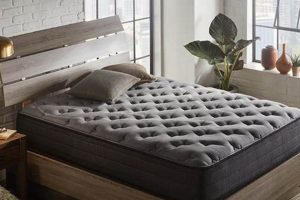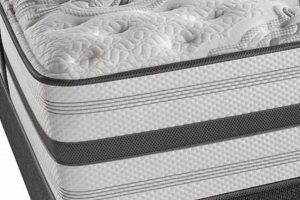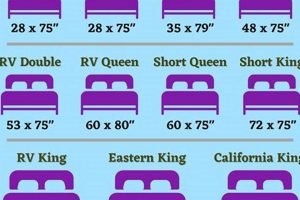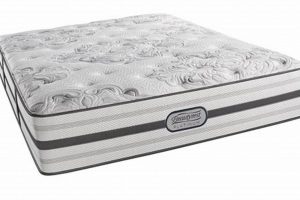A bed designed for single occupants offering customized positioning through mechanical articulation. This sleeping surface allows for raising or lowering the head and foot sections independently, providing enhanced comfort and support. Examples include beds used in homes for individuals requiring specific sleep positions due to medical conditions, or for those seeking lifestyle enhancements like reading or watching television in bed.
The value of these sleep systems lies in their potential to alleviate pressure points, improve circulation, and reduce discomfort associated with certain medical conditions, such as acid reflux or sleep apnea. Their emergence in the market reflects a growing emphasis on personalized comfort and wellness within the bedroom environment. Historically, similar technology was primarily found in hospital beds, but has since evolved for broader consumer use.
Understanding the specifics of construction, available features, warranty information, and potential limitations is crucial before acquisition. Considerations should include the motor’s reliability, the mattress’s material composition, compatibility with existing bedroom furniture, and the overall impact on sleep quality and lifestyle.
Considerations for Adjustable Twin Beds
The following points are crucial when evaluating the suitability of an adjustable single-size bed. Careful consideration of these factors contributes to a satisfactory purchase and long-term use.
Tip 1: Mattress Compatibility: Verify that the mattress intended for use is specifically designed for adjustable bases. Standard mattresses may lack the flexibility required for articulation and could be damaged. Latex or memory foam options are generally suitable.
Tip 2: Motor Quality and Noise: Assess the motor’s operational noise level. A quiet motor is essential for minimizing sleep disturbance. Research the motor’s warranty and reliability ratings.
Tip 3: Weight Capacity: Ascertain the bed’s maximum weight capacity, accounting for both the individual’s weight and the mattress weight. Exceeding the capacity may damage the frame or motor.
Tip 4: Range of Motion: Evaluate the range of motion for head and foot elevation. A wider range offers greater flexibility for customized positioning and comfort.
Tip 5: Remote Functionality: Examine the remote control’s ease of use and available features. Backlit remotes and pre-set positions enhance convenience.
Tip 6: Frame Construction: Inspect the frame’s construction quality. A sturdy frame ensures stability and longevity. Consider the materials used and the overall design.
Tip 7: Warranty Coverage: Review the warranty terms carefully. A comprehensive warranty covering both the frame and motor provides peace of mind and protects against potential defects.
Tip 8: Trial Period: Inquire about the availability of a trial period. This allows for testing the bed’s comfort and functionality in a home setting before committing to a purchase.
Thorough assessment of compatibility, quality, capacity, motion, and warranty contributes to maximizing the benefits derived from an adjustable bed, enhancing comfort and potentially improving sleep quality.
Following these considerations will help in making an informed decision and selecting a system that meets individual requirements and preferences.
1. Motorized Articulation
Motorized articulation is the core mechanism enabling the functionality of an adjustable single-size bed. Without a reliable and precisely controlled motorized system, the bed would be unable to achieve its primary purpose: customizable positioning for enhanced comfort and therapeutic benefit.
- Angle Adjustment Range
The range of angles to which the head and foot sections can be adjusted directly affects the versatility of the bed. A wider range allows for more customized positions to address specific needs, such as alleviating acid reflux or improving circulation. Conversely, a limited range may restrict the bed’s utility and ability to provide optimal comfort.
- Motor Strength and Durability
The motor’s strength determines its ability to lift and support the weight of the user and the mattress without strain. Durable motors ensure longevity and consistent performance over time. A weak or unreliable motor can lead to malfunctions, reduced functionality, and ultimately, a compromised user experience.
- Noise Level During Operation
The noise produced by the motor during adjustments can significantly impact sleep quality. A quiet motor is essential for minimizing disturbances, especially during nighttime adjustments. Loud or jarring noises can disrupt sleep and negate the benefits of having an adjustable bed.
- Control System Precision
The precision of the control system determines the accuracy and responsiveness of the bed’s movements. A precise system allows for fine-tuning the bed’s position to achieve the desired level of comfort. Conversely, a system that lacks precision may result in jerky movements or difficulty in attaining the ideal position.
These facets of motorized articulation directly influence the overall effectiveness and user satisfaction associated with an adjustable twin sleeping surface. Understanding the interplay between these components is crucial for selecting a bed that meets individual needs and delivers long-term value.
2. Size Dimensions
The spatial footprint of an adjustable single-occupancy mattress is a critical determinant of its suitability within a given environment. The physical size dictates not only the comfort afforded to the occupant but also the bed’s compatibility with room layouts and existing furnishings. Precise measurements are, therefore, a fundamental consideration in the selection process.
- Standard Twin Dimensions and Variance
While the nominal dimensions of a standard twin mattress are 38 inches wide and 75 inches long, adjustable bases may introduce slight variations. These variances, often stemming from the frame’s construction or integrated features, can impact overall space requirements. Failure to account for such discrepancies may result in fitting difficulties or limitations in room maneuverability.
- Impact on Room Layout and Functionality
The selected dimensions exert a direct influence on the room’s functionality. A larger adjustable frame may impede movement, restrict access to other furniture, or necessitate rearrangement. Conversely, a smaller, more compact frame may optimize space utilization, particularly in smaller bedrooms or multi-purpose living areas. Careful consideration of room size is, therefore, essential.
- Compatibility with Beddin
g and AccessoriesStandard twin-sized bedding may not always be perfectly compatible with adjustable bases due to their articulated nature. Deep-pocket sheets and flexible mattress protectors are often necessary to accommodate the mattress’s movements without slippage or damage. Attention to bedding compatibility is crucial for maintaining comfort and preventing premature wear.
- Influence on Transport and Setup
The physical dimensions, particularly when disassembled, affect the ease of transport and setup. Larger, more complex frames may require professional installation, while smaller, more modular designs can often be assembled by the consumer. The ease of transport and setup can influence the overall cost and convenience associated with acquiring the bed.
In summary, the size dimensions of an adjustable twin sleeping surface extend beyond mere surface area, influencing factors ranging from room functionality to bedding compatibility. A comprehensive understanding of these spatial considerations is paramount for ensuring a successful integration into the intended environment and maximizing the potential benefits of adjustable sleep technology.
3. Mattress Material
The material composition of a mattress significantly impacts its performance and suitability for use with an adjustable single-occupancy base. An inflexible or poorly constructed mattress can impede the articulation capabilities of the base, potentially damaging the mattress or the base’s mechanical components. Conversely, a mattress designed for adjustable bases allows for full range of motion without compromising support or comfort. Examples of suitable materials include memory foam and latex, which possess inherent flexibility. The practical significance of understanding this connection lies in ensuring optimal performance and longevity of both the mattress and the adjustable base.
Specific material properties directly influence the conformity and durability of the mattress when subjected to repeated articulation. Mattresses with high density foam structures or robust coil systems can withstand bending and shaping without losing support. In contrast, innerspring mattresses with limited flexibility may experience premature wear or coil displacement when paired with an adjustable base. These failures manifest as uneven support, reduced comfort, and potential mechanical problems with the base itself.
Therefore, selecting a mattress material compatible with adjustable bases is paramount for realizing the intended benefits. Considerations should extend beyond initial comfort levels to include long-term durability and the mattress’s ability to maintain its structural integrity under repeated articulation. Failure to address this aspect can negate the advantages of an adjustable system and result in a compromised sleep experience.
4. Frame Durability
The structural integrity of the frame supporting an adjustable twin mattress is paramount to its longevity, functionality, and safety. Frame durability directly influences the system’s ability to withstand the dynamic stresses imposed by repeated articulation and the weight of both the mattress and the occupant. A weak or poorly constructed frame is prone to failure, potentially leading to instability, malfunction, and even injury. The correlation between these factors is that a robust frame provides a stable foundation, enabling the adjustable features to operate smoothly and reliably over an extended period.
An example of inadequate frame construction might involve insufficient welding at joints, leading to metal fatigue and eventual breakage under normal use. Conversely, a frame fabricated from high-gauge steel with reinforced stress points demonstrates greater resistance to deformation and ensures consistent performance. The practical application of this understanding lies in prioritizing frame material and construction quality during the selection process. Scrutinizing warranty information and seeking independent reviews can further validate a frame’s purported durability. Moreover, considering the bed’s intended usage frequency and the occupant’s weight provides a tailored assessment of the necessary frame strength.
In summary, the durability of the frame is not merely a cosmetic attribute but a fundamental aspect determining the overall value and safety of an adjustable twin bed system. Neglecting this factor can result in premature product failure, compromised comfort, and potential risks. Therefore, emphasizing robust frame construction contributes significantly to the long-term satisfaction and utility derived from this type of bed.
5. Remote Control
The remote control serves as the primary interface for operating an adjustable twin mattress, enabling precise control over the bed’s articulation. Its functionality directly affects the user’s ability to customize the sleeping surface for comfort or therapeutic positioning. Without a reliable remote control, the adjustable capabilities are rendered inaccessible, negating the primary benefit of such a bed. For example, an individual seeking relief from acid reflux relies on the remote to elevate the head of the bed, a function impossible to perform without a working control system. The practical significance lies in ensuring the remote is intuitive, durable, and responsive for optimal user experience.
Advanced remote controls may incorporate features such as pre-set positions for reading, watching television, or zero-gravity alignment, allowing for one-touch adjustments. Backlighting enhances visibility in low-light conditions, while memory functions enable users to save personalized settings. Furthermore, some systems offer smartphone integration, providing an alternative control method. These features extend the remote’s utility beyond basic articulation, enhancing convenience and personalization. A faulty remote control, however, can manifest in unresponsive buttons, intermittent connectivity, or complete failure, necessitating replacement or repair.
In essence, the remote control is an indispensable component of an adjustable twin mattress, directly impacting its functionality and user satisfaction. Its design, features, and reliability are critical factors to consider during the selection process. Ensuring the remote is robust and user-friendly is crucial for realizing the full potential of the adjustable bed’s capabilities.
6. Weight Capacity
Weight capacity is a critical specification for an adjustable single-occupancy bed, directly impacting its safe and effective operation. Exceeding the designated weight limit can compromise the structural integrity of the frame and the functionality of the motorized articulation system, leading to potential damage and safety hazards. Consequently, understanding and adhering to the weight capacity is paramount for ensuring both the longevity of the bed and the well-being of the user.
Insufficient weight capacity can manifest in various ways. The motor responsible for adjusting t
he bed’s position may struggle to lift the combined weight of the mattress and occupant, leading to slow or incomplete articulation. Over time, this strain can cause premature motor failure. Additionally, the frame itself may exhibit signs of stress, such as bending or cracking, particularly at weight-bearing joints. In extreme cases, exceeding the weight limit could result in catastrophic frame collapse. As a real-world example, an individual significantly over the weight limit using the bed may find that the head or foot sections do not raise fully, and the motor makes straining sounds during operation.
In conclusion, weight capacity is an intrinsic component of an adjustable single-occupancy bed, not merely an ancillary specification. Correctly assessing the required weight capacity, accounting for both the mattress and the intended user, is essential for safe operation and long-term reliability. Prioritizing this factor minimizes the risk of damage or malfunction and ensures the adjustable bed provides the intended benefits of comfort and personalized positioning.
Frequently Asked Questions Regarding Adjustable Twin Mattresses
This section addresses common inquiries and concerns pertaining to adjustable single-occupancy mattresses, providing clarity on crucial aspects of their design, functionality, and usage.
Question 1: What distinguishes a mattress designed for an adjustable base from a standard mattress?
A mattress intended for use with an adjustable base possesses enhanced flexibility and is constructed from materials capable of withstanding repeated bending and shaping without compromising support. Standard mattresses may lack this inherent flexibility and could be damaged or impede the articulation of the base.
Question 2: How is the weight capacity of an adjustable single-size bed determined?
The weight capacity is established by the manufacturer based on the frame’s structural strength and the motor’s lifting capability. It represents the maximum combined weight of the mattress and occupant that the bed can safely support without risking damage or malfunction.
Question 3: What are the primary benefits associated with adjustable bed technology?
The primary benefits include customizable positioning for enhanced comfort, potential relief from certain medical conditions such as acid reflux or sleep apnea, and improved circulation. These benefits are achieved through the ability to elevate the head and foot sections of the bed independently.
Question 4: Are all mattresses equally suitable for use with adjustable bases?
No. Mattresses constructed from highly flexible materials, such as memory foam or latex, are generally well-suited for adjustable bases. Traditional innerspring mattresses with limited flexibility may not conform properly and could experience premature wear.
Question 5: How does the motor’s noise level impact the overall sleep experience?
Excessive motor noise can disrupt sleep, negating the potential benefits of an adjustable bed. A quiet motor is essential for minimizing disturbances, particularly during nighttime adjustments, ensuring a more restful sleep environment.
Question 6: What factors should be considered when evaluating the warranty for an adjustable twin bed?
The warranty should comprehensively cover both the frame and the motor, providing protection against potential defects in materials or workmanship. The warranty period should be sufficiently long to reflect the expected lifespan of the bed. A comprehensive warranty ensures peace of mind and protects against unexpected repair costs.
Understanding these key aspects is vital for making an informed decision when selecting a adjustable single-size mattress, maximizing its value and long-term utility.
The next section delves into the specific accessories commonly associated with adjustable beds and their respective benefits.
Conclusion
The preceding analysis has provided a comprehensive overview of the adjustable twin mattress, encompassing its definition, benefits, critical features, and common considerations. Emphasis has been placed on motorized articulation, size dimensions, mattress material, frame durability, remote control functionality, and weight capacity as key determinants of suitability and long-term value. This exploration aims to furnish prospective purchasers with the requisite knowledge to make informed decisions.
The adjustable twin mattress represents a significant advancement in personalized sleep technology, offering the potential for enhanced comfort and therapeutic benefit. Prudent evaluation of individual needs, coupled with careful consideration of the factors outlined herein, will optimize the likelihood of a satisfactory acquisition and contribute to improved sleep quality. Future advancements in materials science and motor technology are anticipated to further refine these systems, solidifying their role in promoting well-being.







![Deals on Twin Mattress Black Friday Sale [Year] | [Brand] Organic & Natural Mattress Buyer’s Guide: Non-Toxic Sleep Solutions Deals on Twin Mattress Black Friday Sale [Year] | [Brand] | Organic & Natural Mattress Buyer’s Guide: Non-Toxic Sleep Solutions](https://mattressworldpa.com/wp-content/uploads/2025/07/th-5066-300x200.jpg)